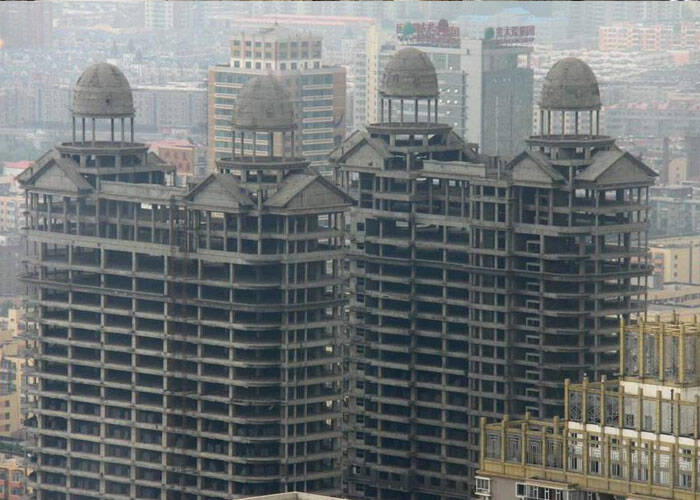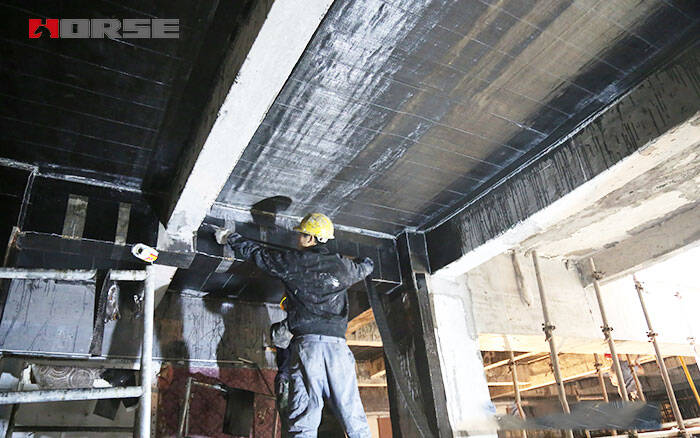Solutions
Horse Construction offers full range of structural strengthening materials with technical supports, documentation supports, products supports, project supports.
Carbon Fiber Reinforcement in the Continued Construction of the Unfinished Building

Introduction
With the continuous advancement of urban construction and the implementation of the concept of sustainable development, we have strengthened the emphasis on the continued construction and reinforcement of unfinished buildings, and promoted the rational use of unfinished project resources with minimal economic investment. Ultimately, it drives the efficient development of urban construction and achieves a win-win situation for both economic and social benefits.
Carbon fiber reinforcement technology is a reinforcement technology that has gradually been widely used in construction projects in recent years. The method adopts carbon fiber composite material, and uses structural glue to stick it tightly on the surface of the concrete structure at room temperature, so that the two as a whole, bear the force together. It is a simple and excellent reinforcement method. Different from traditional bonded steel reinforcement, carbon fiber reinforcement technology is convenient to construct, and achieves the purpose of effective addition without increasing the structural load. The restored concrete structure has obvious advantages such as high strength, high efficiency, corrosion resistance, light weight, and no increase in structural size. This article combines engineering examples to introduce the construction technology, quality control measures and points of attention of this technology.
Project Overview
Building C of a square next to Fuzhou Liuyi Ring Island. The project was originally designed as a frame-and-simplified structure. It is planned to build a 28-story apartment-style office building. However, in the actual construction process, due to various causes such as the relocation of the owner's headquarters, the project was finally put into use as a shopping mall after the construction of the fifth floor of the podium was completed, and the construction of the upper part did not continue. When resuming work, due to the update and revision of the design specifications, the national standards have increased the structural safety requirements, resulting in some beams and slab reinforcements that have been built cannot meet the requirements of the current specifications. In order to ensure the quality and safety of the project, after the inspection and appraisal by the inspection unit, the original design unit calculated and reviewed the existing structure, and decided to use unidirectional carbon fiber cloth reinforcement technology for reinforcement treatment

Carbon fiber reinforcement process and operating points
1 Construction preparation
(1) Be familiar with the construction drawings of Jiatong design before construction. According to the actual conditions of the construction site and the reinforced concrete components, a feasible construction plan is formulated; the line is positioned at the reinforced position according to the requirements of the construction drawings, and the materials used are prepared and accepted before the construction.
(2) The performance index of the selected carbon fiber composite material meets the requirements of the carbon fiber composite material performance index in the specification.
2 surface treatment
Clean the concrete surface to be reinforced and polish it. If the steel bars are exposed, the steel bars should be derusted first, and then repaired with leveling glue. The protruding part of the surface is smoothed with a grinder, and the concave corners and irregularities are filled with leveling glue. The corner paste should be chamfered, and the arc radius R is greater than or equal to 20mm. If there are cracks in the concrete, it should be sealed with structural adhesive before reinforcement. After the surface of the concrete is treated, blow it with compressed air. The surface of the concrete should be clean, dry and free of oil.
3 Brush the primer
During construction, weigh the main agent and curing agent in a certain ratio according to the specified glue ratio, pour them into a clean container, and stir them evenly. Use a brush or a barrel brush to apply uniformly on the surface of the concrete. After the surface of the glue is dry, the thickness of the primer should not exceed 0.4mm, and there should be no leakage, flow or bubbles. After the primer is cured (the curing time is determined by the temperature on site, it is better to dry by hand, generally not less than 2 hours), and then proceed to the next process.
4 repair and leveling
Prepare the leveling glue according to the regulations, repair and fill up the concave parts of the concrete surface with a scraper, and use the leveling glue to fill the height difference of the formwork joints. The corners should be treated with leveling glue into a smooth arc with a radius greater than 20 ram. After the leveling glue is cured (the curing time is determined by the on-site temperature, it is advisable to dry by hand, generally not less than 2 hours), and then proceed to the next process.
5 Brushing, pasting and curing
(1) Brush the glue to cut the carbon fiber cloth according to the size required by the design, and then apply the prepared impregnating glue evenly on the concrete surface of the sticking part.
(2) Lay the cut carbon fiber cloth on the concrete surface coated with impregnated glue according to the position of the thread. The carbon fiber cloth should be fully flattened and there should be no wrinkles. Use a special smooth roller to compact evenly and smoothly along the fiber direction on the surface where the fiber cloth has been pasted. The rolled fiber cloth must be repeatedly rolled in the same direction to squeeze out the air bubbles. Until the impregnation is full, and the fiber cloth layer is evenly compacted, without bubbles. When carbon fiber cloth needs to be overlapped, the overlap length should not be less than 100mm. Finally, apply a layer of dipping glue evenly on the surface of the carbon fiber cloth.
When multiple layers are to be pasted, the next layer should be pasted immediately after the surface of the fiber cloth is dry to the touch. Each layer is constructed separately. If the construction time between each two layers is delayed> 1 hour, you should wait 12 hours before repeating the above steps to continue pasting.
(3) Maintenance After completion of construction, attention should be paid to product protection to prevent bumps. The curing temperature should not be lower than 5℃. When the average temperature is 10-25℃, the curing time should not be less than 3-7 days. When the average temperature is 10℃, the curing time shall not be less than 7-10 days.
Concluding remarks
The practice of using carbon fiber to reinforce the local beams and slabs of an unfinished building in a square next to Fuzhou’s Liuyi roundabout has proved that carbon fiber reinforcement technology avoids the disadvantages of other reinforcement methods such as increasing the structure size, reducing the building area, increasing the weight, and long construction period. And it can effectively guarantee the quality and safety of the project. The comprehensive benefits in the reinforcement project of unfinished buildings are significant, which can be used as a reference for similar projects.
You can find anything here you are in need of, have a trust trying on these products, you will find the big difference after that.

High strength, unidirectional carbon fiber wrap pre-saturated to form a carbon fiber reinforced polymer (CFRP) wrap used to strengthen structural concrete elements.

High strength, unidirectional carbon fiber fabric pre-saturated to form a carbon fiber reinforced polymer (CFRP) fabric used to strengthen structural concrete elements.

High strength, unidirectional carbon fiber sheet pre-saturated to form a carbon fiber reinforced polymer (CFRP) sheet used to strengthen structural concrete elements.